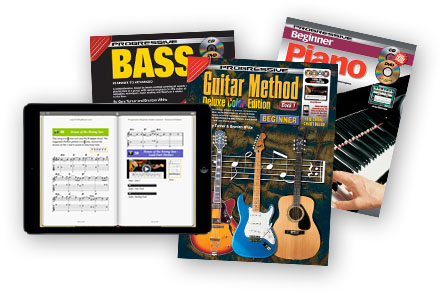<< First < Previous | Intro 1 2 3 4 5 | Next > Last >>
Back to Table of Contents
Pivot Finger
When changing between the F and G7 chords, do not move your first finger as it is common to both chords. The first finger acts as a pivot around which the other fingers move. This will make the chord changes easier.
| 6 |
Video
Open Chord Shapes
All the chord shapes you are learning here are examples of open chords, which means they contain open strings (i.e., no finger is placed on the fret). Later in the book, you will learn other chord types (e.g., bar chords) which do not contain open strings.
The Lead-In
Sometimes a song does not begin on the first beat of the bar. Any notes which come before the first full bar are called lead-in notes (or pick-up notes). When lead-in notes are used, the last bar is also incomplete. The notes in the lead-in and the notes in the last bar add up to one full bar. When you are playing chords, do not strum until the first full bar after the lead-in notes.
| 7 | When The Saints Go Marchin’ In |
Practice each of the chord changes and then play the whole song. When changing between the F and G7 chords, use your first finger as a pivot. When changing between G7 and C, slide your third finger along the first string.
| 7 | When The Saints Go Marchin’ In |
Video
12 Bar Blues
12 Bar Blues is a pattern of chords which repeat every 12 bars. There are hundreds of songs based on this chord progression, i.e., they contain basically the same chords in the same order. 12 Bar Blues is commonly used in Rock music and is the basis of Blues music.
Some well-known songs which use this 12 bar chord pattern are:
- Original Batman TV Theme
- Rock Around the Clock – Bill Haley
- Johnny B Goode – Chuck Berry
- Blue Suede Shoes – Elvis Presley
- In the Mood – Glenn Miller
- Surfin’ USA – The Beach Boys
- In the Summertime – Mungo Jerry
- Long Tall Glasses – Leo Sayer
- Killing Floor – Jimi Hendrix
- Stuck in the Middle With You – Stealer’s Wheel
- Give Me One Reason – Tracy Chapman
- Why Didn’t You Call Me? – Macy Gray
The following 12 Bar Blues is in the key of C major. When a song is said to be in the key of C major, it means that the most important chord (and usually the first chord) is the C chord.
This pattern of chords will probably sound familiar to you. Instead of writing a chord symbol above each bar of music, it is common to only write a chord symbol when the chord changes. For example, the first four bars of this Blues are all C chords, played according to the rhythm pattern. To help keep time, accent (play louder) the first strum of every bar. End this 12 Bar Blues by strumming a C chord.
| 8 | 12 Bar Blues in C |
Video
<< First < Previous | Intro 1 2 3 4 5 | Next > Last >>
Back to Table of Contents


































